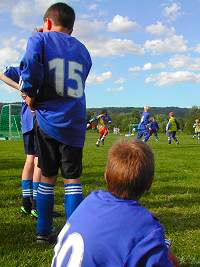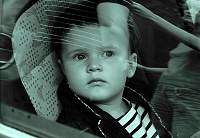 According to figures from the U.S. Census Bureau, there are 2.1 million adopted children and 4.4 million stepchildren of householders as estimated from the Census 2000 sample. Together, these children represented approximately 8 percent of the 84 million sons and daughters of householders in 2000.
According to figures from the U.S. Census Bureau, there are 2.1 million adopted children and 4.4 million stepchildren of householders as estimated from the Census 2000 sample. Together, these children represented approximately 8 percent of the 84 million sons and daughters of householders in 2000.
It is a fact, based upon several recent surveys, that children in adoptive households are treated better than children in homes with two biological parents! Adoptive parents were more likely to enrich their children’s lives to compensate for the lack of biological ties and invest more effort recognizing that adopted children needed more help to succeed. Nigel Barber, Ph.D., author of Kindness in a Cruel World, wrote a fascinating article in Psychology Today Blogs on June 1, 2009, about the subject (click here to read). He analyzed two recent studies, both of which have findings that are inconsistent with the fairy-tale claim that parents cannot treat genetically unrelated children as well as their own kin.
In a study of homes having one natural child and one adopted child using records provided by an adoption agency for over 22 years, anthropologist, Kyle Gibson, concluded that adopted children were more likely to attend preschool and to … Read More... “Fact or Fiction: Biological Children Fare Better Than Adopted Children?”


 Our responsibility as parents is to nurture and protect our children. We do everything possible to ensure their physical safety and to care for their emotional and psychological needs as well. It seems a bit odd to think that many children and teens feel like it is their responsibility to protect us.
Our responsibility as parents is to nurture and protect our children. We do everything possible to ensure their physical safety and to care for their emotional and psychological needs as well. It seems a bit odd to think that many children and teens feel like it is their responsibility to protect us. One of the most interesting and well written pieces that I have read in a long time is a keynote address presented by Dr. Frank S. Williams to the National Council for Children’s Rights in Washington D.C. on October 20, 1990. Dr. Williams is a noted child psychiatrist and the Director of Family and Child Psychiatry at Cedars-Sinai Medical Center in Los Angeles. While this presentation was almost 19 years ago, Dr. Williams’ sage advice is no less relevant now than it ever was!
One of the most interesting and well written pieces that I have read in a long time is a keynote address presented by Dr. Frank S. Williams to the National Council for Children’s Rights in Washington D.C. on October 20, 1990. Dr. Williams is a noted child psychiatrist and the Director of Family and Child Psychiatry at Cedars-Sinai Medical Center in Los Angeles. While this presentation was almost 19 years ago, Dr. Williams’ sage advice is no less relevant now than it ever was! The Ohio Supreme Court instituted new rules on March 1, 2009, regarding the role and responsibilities of a Guardian ad Litem (GAL). Ohio Rule of Superintendence 48 codifies these rules. As background, a GAL is a person appointed by the court in both domestic relations and juvenile cases to protect the best interest of the child. The GAL typically issues a Report to the court detailing the investigation and setting forth a recommendation. It is not uncommon for a GAL to be involved in most juvenile cases and in many domestic relations cases involving minor children. Prior to Rule 48 there were no uniform GAL rules in Ohio, but many courts have had their own rules; and in addition, lawyers serving as GAL’s were bound by the Ohio Rules of Professional Conduct.
The Ohio Supreme Court instituted new rules on March 1, 2009, regarding the role and responsibilities of a Guardian ad Litem (GAL). Ohio Rule of Superintendence 48 codifies these rules. As background, a GAL is a person appointed by the court in both domestic relations and juvenile cases to protect the best interest of the child. The GAL typically issues a Report to the court detailing the investigation and setting forth a recommendation. It is not uncommon for a GAL to be involved in most juvenile cases and in many domestic relations cases involving minor children. Prior to Rule 48 there were no uniform GAL rules in Ohio, but many courts have had their own rules; and in addition, lawyers serving as GAL’s were bound by the Ohio Rules of Professional Conduct. A recurring battle that I see in my family law practice is how to juggle a child’s extracurricular activities after a divorce. There is no black and white answer, of course, to this question. In many cases where there is shared parenting or both mother and father continue to communicate with each other and place the child’s best interest in perspective, both parents will attend the child’s after-school activities and will seamlessly foster the child’s continued participation in the activities no matter which home the child may be residing in. However, in a large number of post-divorce situations, especially in high conflict cases or where the parties do not live in close proximity with one another, continuation of extracurricular activities can present a major problem.
A recurring battle that I see in my family law practice is how to juggle a child’s extracurricular activities after a divorce. There is no black and white answer, of course, to this question. In many cases where there is shared parenting or both mother and father continue to communicate with each other and place the child’s best interest in perspective, both parents will attend the child’s after-school activities and will seamlessly foster the child’s continued participation in the activities no matter which home the child may be residing in. However, in a large number of post-divorce situations, especially in high conflict cases or where the parties do not live in close proximity with one another, continuation of extracurricular activities can present a major problem.
 On January 6, 2009, Governor Strickland signed
On January 6, 2009, Governor Strickland signed